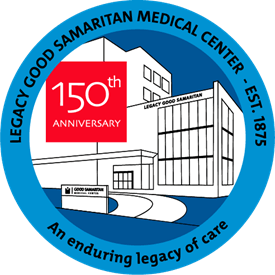


An enduring legacy of care.
The legacy of Legacy Good Samaritan Medical Center is one of exceptional care and service to the Portland community. Here, babies have been born. Loved ones have been treated. Many innovative “firsts” in medicine — for Portland, for Oregon and for the nation — have been achieved here. In 2025, Legacy Good Samaritan celebrates its 150th anniversary. We invite you to learn more about one of the oldest continuously operating institutions in the Pacific Northwest.
The Past


Beginnings
1875
Good Samaritan Hospital, as Legacy Good Samaritan was known at the time, opens on Oct. 9 with 50 beds and a staff of five. Founded by Episcopal Bishop Benjamin Wistar Morris, the hospital cost $10,000 to build ($292,200 in 2025 dollars).
1887
The University of Oregon Medical School opens at Good Samaritan, one of the few medical schools west of the Rocky Mountains. The medical school later becomes Oregon Health & Science University.
1890
Good Samaritan nurse Emily Loveridge opens the first school of nursing at a hospital in the Pacific Northwest — Good Samaritan Hospital Training School for Nurses.


Growth
1905
Emily Loveridge is appointed as superintendent. She is the first female administrator of a hospital in the United State and holds the position for 25 years.
1921
East Wing and Wilcox Maternity Hospital are built. The Wilcox Hospital is the first maternity facility in Oregon and is named after Theodore B. Wilcox, a Portland businessman.


Expansion
1928
The Cancer Clinic is organized at Good Samaritan Hospital.
1930
Good Samaritan installs the first electrocardiogram (EKG) machine in Portland.
1948
The Portland Rehabilitation Center, which later becomes Rehabilitation Institute of Oregon (RIO), opens.


Modernization
1959
Devers Memorial Eye Clinic opens. It’s named after coffee merchant Arthur H. Devers, who donated $1 million to help fund eye care for Oregonians.
1965
Good Samaritan opens the first dialysis department in Oregon and becomes the first Oregon hospital to treat patients with irreversible kidney damage.
1968
Good Samaritan surgeon Dr. U. Scott Page begins performing open-heart valve replacement surgeries, thus placing Good Samaritan in the ranks of leading medical centers.


Innovation
1981
Dr. Mark Hattenhauer, assisted by Dr. John Rush, performs the first coronary angioplasty in Oregon.
1985
The Neurological Sciences Center opens and becomes the region’s only center devoted to the treatment and testing of problems related to neurological sciences. Separately, Good Samaritan Nursing School closes and merges with the nursing program at Linfield College (now Linfield University).
1989
Good Samaritan joins HealthLink, which operates Emanuel, Holladay Park, Meridian Park and Mount Hood medical centers. Together, they form the Legacy Health System. Legacy Good Samaritan also establishes the Diabetes Institute, the first in the region to focus on diabetes treatment, education and research.
1991
The first bloodless surgery and medicine program in the United States — and the second in the world — opens at Legacy Good Samaritan. Two years later, the first pediatric program also opens. Both programs bring international recognition to Legacy.
1998
The Breast Health Center opens at Legacy Good Samaritan. Offering comprehensive services, the center is the first of its kind in Oregon.
2000
Dr. Mark Terry, director of Corneal Services at Legacy Devers Eye Institute, performs the first endothelial keratoplasty in the United States.


Specialization
2001
Legacy Good Samaritan conducts the first hip fracture service in Oregon and one of the few in the U.S. The service is a collaborative effort between geriatricians and orthopedic surgeons.
2005
The medical center starts its first weight-loss surgery program, which becomes the first bariatric program to be accredited on the West Coast by the American College of Surgeons. The program is later renamed the Legacy Weight and Diabetes Institute.
2007
Legacy Good Samaritan’s Oncology Nurse Navigation program — the first in the region — begins.
2013
Legacy Good Samaritan is the first hospital in the U.S. to achieve disease-specific certifications in six cardiac areas. The hospital is awarded a total of 12 centers of excellence in cardiac, orthopedics, spine and stroke.
2014
Legacy Good Samaritan develops a regional resource for high-risk infectious diseases. The Biological Isolation Care Unit is surveyed and approved by the Centers for Disease Control and Prevention.
2015
First partial thickness corneal transplant on a child in the U.S. is performed by Mark Terry, MD.
The Present
150 years of exceptionally good Samaritans and counting.
From quiet — almost humble — beginnings to a critical role within a major health system, Legacy Good Samaritan continues to thrive and grow today. And that’s because of its amazing staff, comprehensive service lines and the day-to-day successes of saving lives, fighting cancer and bringing bundles of joy into the world.
As of 2025, Legacy Good Samaritan has grown to include:
700nursesone of the core groupson the frontlines |
2,200staffa far cry from the50 we started with! |
13,000surgeriesof every kind imaginable per year, from kidney transplants to mending bones |
Our community presence
Being here for good, being here for you — starts with those who bring Legacy Good Samaritan to life 365 days a year. These are the workers who care for patients, save lives and comfort patients. The Good Samaritans. These are some of their inspiring stories.
Legacy Good Samaritan’s key services
From the general to the specialized, Legacy Good Samaritan provides services that are essential to maintaining health and saving lives: Treating cancer, performing transplants, elevating eye health and much more. These service lines are among the most relied upon locally and even regionally in the Pacific Northwest.

Devers Eye Institute
Legacy Devers Eye Institute offers expertise in eye-related procedures such as cataract surgery and LASIK, common optometric procedures, and specialized care for a wide range of complicated eye diseases. Patients come from across the Pacific Northwest and around the world for our expert care.

Rehabilitation Institute of Oregon
Legacy Rehabilitation Institute of Oregon (RIO) at Legacy Good Samaritan Medical Center is an inpatient rehabilitation facility that provides the highest level of care. Legacy RIO coordinates job training, counseling, and physical and occupational therapies in the same location. This coordinated approach gives patients the best chance for positive results. Legacy RIO has received a three-year accreditation from the Commission on the Accreditation of Rehabilitation Facilities.

Legacy Cancer Institute
As one of the nation’s leading cancer programs, Legacy Cancer Institute (LCI) approaches each patient with compassion and the belief that everyone is unique and different. That’s why LCI considers a patient’s physical, emotional and spiritual well-being when creating a treatment program for patients. Our entire team of cancer specialists work collaboratively to develop a treatment plan that is unique to you and your diagnosis.

Transplant Services
Legacy Transplant Services offers the most advanced medical care focused on transplants. Our team includes surgeons, medical specialists, nurse coordinators, social workers and other staff members who provide superior, specialized expertise throughout the transplant process. The team has specific expertise in kidney, bone marrow and stem cell transplant services.




